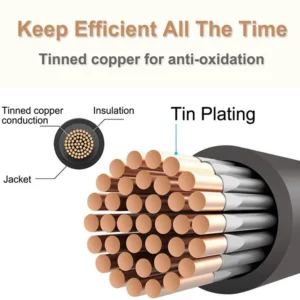Choosing the right solar cables and extension cables can be instrumental in optimizing the performance, efficiency, and safety of your solar power system. When you are installing a new off-grid system or upgrading an existing one, having information on the key characteristics of solar cables can help you make the proper purchases.
This 2025 buying guide has got you covered from cable types to size, insulation, connectors, and top product recommendations. Let‘s get started!
Why Selecting the Proper Solar Cables Is Important solar cable
Solar cables channel the electricity your solar panels supply to inverters, batteries, and charge controllers. Cheap or low-quality cables can result in:
➖Power loss
➖Fire or overheating risk
➖System inefficiencies
➖Voided equipment warranties
With properly sized, high-quality cables, you are guaranteed improved conductivity, life, and system durability.
What are Solar Cables and their Applications?
Solar cables, or photovoltaic (PV) cables, are cables designed specifically to be utilized in solar power systems. They are mostly used to transport direct current (DC) electricity from solar panels to other equipment like inverters and batteries.
Key Functions:
🟢✔️ Transfer DC electricity efficiently and securely
🟢✔️ Withstand environmental conditions like exposure to UV light, temperature fluctuations, and humidity
🟢✔️ Maintain consistent performance over time with minimal power loss
What Are Solar Panel Extension Cables and Where Are They Used?
Solar panel extension cables are pre-installed cables used to lengthen the connection between solar panels and other system components. They are often provided with MC4 connectors for ease of use.
Key Functions:
🟢✔️Increase panel-to-part distance without loss of power
🟢✔️Offer plug-and-play ease of use for novice and experienced installers
🟢✔️Support modular system design and complex installations
Solar Cable Types

1. PV Wire (Photovoltaic Wire)
➖ Single-conductor outdoor solar cable
➖ Weather and UV resistant
➖ Typically used to connect solar panels in series
2. MC4 Extension Cables
➖ MC4-terminated cables
➖ Excellent for quick plug-and-play panel extension
➖ Excellent for do-it-yourself panel extension and modular system extension
3. THHN/THWN Wire (Indoor Wiring)
➖ Not sunlight resistant except if routed through conduit
➖Recommended for indoor installations to connect inverters or charge controllers
Key Factors to Consider When Choosing Solar Cables
1. Cable Diameter (Gauge)
Cable thickness impacts current ability and voltage drop
Standard gauges: 10 AWG, 12 AWG, and 14 AWG
Calculate using a voltage drop calculator to determine the optimal size based on distance and power output
2. Insulation and Jacket Material
Utilize UV-resistant and weatherproof insulation if installed outside
Double insulation adds extra protection for harsh environments
3. Voltage Rating
Ensure cables are rated as high as or even higher than your system’s voltage (usually 600V to 2000V)
4. Temperature Rating
Cables should withstand high temperatures, especially in sunny, exposed locations
Look for a rating of -40°C to +90°C or even better
5. Connectors Compatibility
MC4 connectors are on most solar panels
Ensure your cables are compatible or supplied with proper adapters
Best Solar Panel Extension Cables in 2025
Here are some of the top-rated solar panel extension cables that are trending among solar pros and enthusiasts. All of them can be bought via our affiliate partner, Eco-Worthy, and they ship to the U.S., U.K., Canada, New Zealand, and Australia.
1. Eco-Worthy Solar Extension Cable (10 AWG, 20Ft)
UV-resistant, waterproof, and MC4 connector compatible
Ideal for RV, boat, and home installation
Buy from Eco-Worthy – U.S./U.K./CA/NZ/AU
2. Eco-Worthy PV Extension Cable Kit (12 AWG, 40Ft)
Abrasion-resistant abrasion-insulated tinned copper wire
Sold in red/black set for easy identification and easy installation
3. Eco-Worthy Complete Solar Cable Kit
Includes extension cables and grounding cables
Designed to be simple to use and long-lasting
Check Availability on Eco-Worthy
Installation Tips for Solar Cables
Measure Twice, Cut Once: Carefully plan your cable runs so that you avoid short or excessively long cables.
Minimize Voltage Drop: Use heavier cables for longer lengths.
Secure Properly: Use UV-rated cable ties and mounting points to secure cables.
Avoid Sharp Bends: Bends should be kept soft to avoid crushing cables.
Label Everything: Proper labeling allows for easy troubleshooting and maintenance.
Frequently Asked Questions (FAQs)
1. Should I use regular electrical cables in my solar system?
No. Ordinary electrical wire usually does not have UV resistance and suitable voltage ratings for outdoor solar applications. Always employ solar-rated PV cable or approved extension cords.
2. What is the difference between 10 AWG and 12 AWG wire?
10 AWG is larger and will carry more current over longer runs with less voltage drop. It is generally ideal for higher watt systems.
3. Are MC4 connectors required?
Yes. MC4 connectors offer a secure, weatherproof, and safe panel-to-cable connection. They’re now the standard.
Wrap it Up
Choosing solar cables and extension cables isn’t just about compatibility—it’s about safety, efficiency, and system longevity. Whether you’re new to the game or retro-fitting an existing system, investing money in quality cables can protect your gear and enhance performance.
Do not forget to shop from authentic suppliers such as Eco-Worthy, which provides certified, high-grade solar cables to customers in the U.S., U.K., Canada, New Zealand, and Australia.
Ready to upgrade your solar kit?
➡️ Buy Shop Eco-Worthy top-selling solar cables and accessories here
Affiliate Disclosure: This article contains affiliate links. If you purchase through these links, we may earn a commission at no extra cost to you.
Author
Top Solar Picks, founded by John, a Solar Energy Writer and Researcher with over 12 years of experience in renewable energy, is dedicated to helping homeowners and businesses make informed, data-driven decisions about solar power. John’s expertise and research pr...

